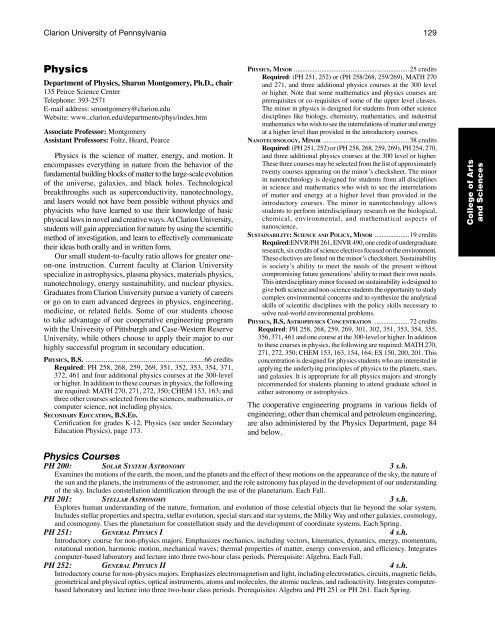Undergraduate - Clarion University
Undergraduate - Clarion University
Undergraduate - Clarion University
- No tags were found...
You also want an ePaper? Increase the reach of your titles
YUMPU automatically turns print PDFs into web optimized ePapers that Google loves.
<strong>Clarion</strong> <strong>University</strong> of Pennsylvania 129PhysicsDepartment of Physics, Sharon Montgomery, Ph.D., chair135 Peirce Science CenterTelephone: 393-2571E-mail address: smontgomery@clarion.eduWebsite: www..clarion.edu/departments/phys/index.htmAssociate Professor: MontgomeryAssistant Professors: Foltz, Heard, PearcePhysics is the science of matter, energy, and motion. Itencompasses everything in nature from the behavior of thefundamental building blocks of matter to the large-scale evolutionof the universe, galaxies, and black holes. Technologicalbreakthroughs such as superconductivity, nanotechnology,and lasers would not have been possible without physics andphysicists who have learned to use their knowledge of basicphysical laws in novel and creative ways. At <strong>Clarion</strong> <strong>University</strong>,students will gain appreciation for nature by using the scientificmethod of investigation, and learn to effectively communicatetheir ideas both orally and in written form.Our small student-to-faculty ratio allows for greater oneon-oneinstruction. Current faculty at <strong>Clarion</strong> <strong>University</strong>specialize in astrophysics, plasma physics, materials physics,nanotechnology, energy sustainability, and nuclear physics.Graduates from <strong>Clarion</strong> <strong>University</strong> pursue a variety of careersor go on to earn advanced degrees in physics, engineering,medicine, or related fields. Some of our students chooseto take advantage of our cooperative engineering programwith the <strong>University</strong> of Pittsburgh and Case-Western Reserve<strong>University</strong>, while others choose to apply their major to ourhighly successful program in secondary education.Physics, B.S. .................................................................66 creditsRequired: PH 258, 268, 259, 269, 351, 352, 353, 354, 371,372, 461 and four additional physics courses at the 300-levelor higher. In addition to these courses in physics, the followingare required: MATH 270, 271, 272, 350; CHEM 153, 163; andthree other courses selected from the sciences, mathematics, orcomputer science, not including physics.Secondary Education, B.S.Ed.Certification for grades K-12, Physics (see under SecondaryEducation Physics), page 173.Physics, Minor ...................................................................25 creditsRequired: (PH 251, 252) or (PH 258/268, 259/269), MATH 270and 271, and three additional physics courses at the 300 levelor higher. Note that some mathematics and physics courses areprerequisites or co-requisites of some of the upper level classes.The minor in physics is designed for students from other sciencedisciplines like biology, chemistry, mathematics, and industrialmathematics who wish to see the interrelations of matter and energyat a higher level than provided in the introductory courses.Nanotechnology, Minor ...................................................38 creditsRequired: (PH 251, 252) or (PH 258, 268, 259, 269), PH 254, 270,and three additional physics courses at the 300 level or higher.These three courses may be selected from the list of approximatelytwenty courses appearing on the minor’s checksheet. The minorin nanotechnology is designed for students from all disciplinesin science and mathematics who wish to see the interrelationsof matter and energy at a higher level than provided in theintroductory courses. The minor in nanotechnology allowsstudents to perform interdisciplinary research on the biological,chemical, environmental, and mathematical aspects ofnanoscience.Sustainability: Science and Policy, Minor ....................19 creditsRequired:ENVR/PH 261, ENVR 490, one credit of undergraduateresearch, six credits of science electives focused on the environment.These electives are listed on the minor’s checksheet. Sustainabilityis society’s ability to meet the needs of the present withoutcompromising future generations’ ability to meet their own needs.This interdisciplinary minor focused on sustainability is designed togive both science and non-science students the opportunity to studycomplex environmental concerns and to synthesize the analyticalskills of scientific disciplines with the policy skills necessary tosolve real-world environmental problems.Physics, B.S, Astrophysics Concentration .....................72 creditsRequired: PH 258, 268, 259, 269, 301, 302, 351, 353, 354, 355,356, 371, 461 and one course at the 300-level or higher. In additionto these courses in physics, the following are required: MATH 270,271, 272, 350; CHEM 153, 163, 154, 164; ES 150, 200, 201. Thisconcentration is designed for physics students who are interested inapplying the underlying principles of physics to the planets, stars,and galaxies. It is appropriate for all physics majors and stronglyrecommended for students planning to attend graduate school ineither astronomy or astrophysics.The cooperative engineering programs in various fields ofengineering, other than chemical and petroleum engineering,are also administered by the Physics Department, page 84and below.pages i-viiCollege of Artsand SciencesPhysics CoursesPH 200: Solar System Astronomy 3 s.h.Examines the motions of the earth, the moon, and the planets and the effect of these motions on the appearance of the sky, the nature ofthe sun and the planets, the instruments of the astronomer, and the role astronomy has played in the development of our understandingof the sky. Includes constellation identification through the use of the planetarium. Each Fall.PH 201: Stellar Astronomy 3 s.h.Explores human understanding of the nature, formation, and evolution of those celestial objects that lie beyond the solar system.Includes stellar properties and spectra, stellar evolution, special stars and star systems, the Milky Way and other galaxies, cosmology,and cosmogony. Uses the planetarium for constellation study and the development of coordinate systems. Each Spring.PH 251: General Physics I 4 s.h.Introductory course for non-physics majors. Emphasizes mechanics, including vectors, kinematics, dynamics, energy, momentum,rotational motion, harmonic motion, mechanical waves; thermal properties of matter, energy conversion, and efficiency. Integratescomputer-based laboratory and lecture into three two-hour class periods. Prerequisite: Algebra. Each Fall.PH 252: General Physics II 4 s.h.Introductory course for non-physics majors. Emphasizes electromagnetism and light, including electrostatics, circuits, magnetic fields,geometrical and physical optics, optical instruments, atoms and molecules, the atomic nucleus, and radioactivity. Integrates computerbasedlaboratory and lecture into three two-hour class periods. Prerequisites: Algebra and PH 251 or PH 261. Each Spring.
















